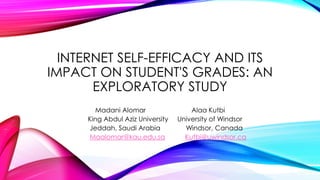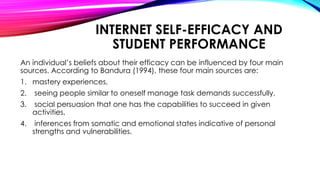This document summarizes a study that examined the relationship between students' internet self-efficacy and their grades when using social media as a learning tool. The study hypothesized that students with high internet self-efficacy would earn higher overall grades. It involved surveying 40 undergraduate students about their internet self-efficacy and analyzing their course grades. Regression analysis found a positive correlation between self-efficacy scores and grades. Students with higher self-efficacy tended to earn higher grades, supporting the hypothesis.






![INTERNET SELF-EFFICACY AND
STUDENT PERFORMANCE
Bandura and Wood (1989) define self-efficacy as
“[the] beliefs in one’s capabilities to mobilize the
motivation, cognitive resources and courses of action
needed to meet situational demands” (p. 260).](https://image.slidesharecdn.com/alaak-190821191622/85/Alaa-k-7-320.jpg)












